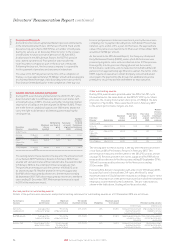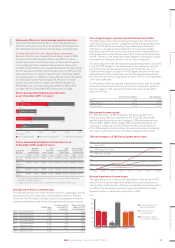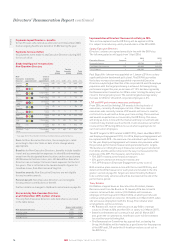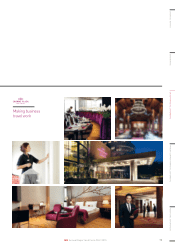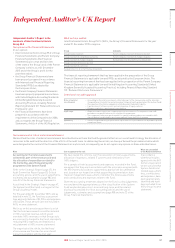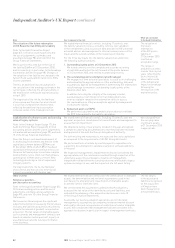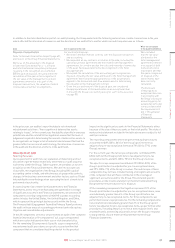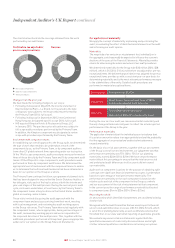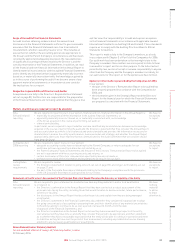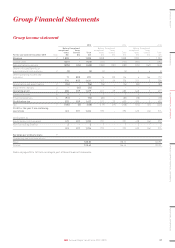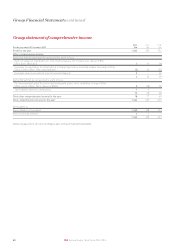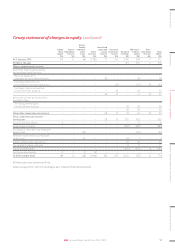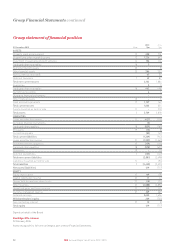Holiday Inn 2015 Annual Report Download - page 84
Download and view the complete annual report
Please find page 84 of the 2015 Holiday Inn annual report below. You can navigate through the pages in the report by either clicking on the pages listed below, or by using the keyword search tool below to find specific information within the annual report.
Independent Auditor’s UK Report continued
Risk Our response to the risk
What we concluded
to the Audit Committee
The valuation of the future redemption
of IHG Rewards Club (IRC) points liability
Refer to the Audit Committee Report
(page 63); Critical accounting policies and
the use of judgements, estimates and
assumptions (page 98); and note 32 of the
Group Financial Statements.
We focused on this area due to the size of
the liability ($649m at 31 December 2015),
and its sensitivity, in particular, to the breakage
estimate (as defined on page 98). Changes in
the valuation of the liability are charged to the
System Fund surplus/deficit and not to IHG’s
income statement.
There is an additional input assumption in
the calculation of the breakage estimate in the
current year, reflecting the announcement of
the modification to the point expiration policy
in April 2015.
The magnitude of the risk (ie, the likelihood
of occurrence and the size of an error should
it occur) has increased from the prior year,
reflecting the additional input assumption
in the calculation of the breakage estimate.
We tested internal financial controls, including IT controls, over
the liability valuation process, including controls over validation
of the completeness and accuracy of data provided to IHG’s external
actuarial adviser and management’s internal review process of the
inputs and the overall estimate of the rewards point liability.
For the three key inputs into the liability valuation we undertook
the following audit procedures:
1. Outstanding loyalty points at 31 December 2015
We tested controls over the complete and accurate recording
of point data and tested the roll forward of the points balance
to 31 December 2015, and verified to underlying records.
2. The outstanding points redemption ratio (breakage)
We engaged our own actuarial specialists to assist us in challenging
and evaluating the appropriateness of the methodology, data and
assumptions applied by management in determining the redemption
ratio/breakage for member’s outstanding loyalty points at the
balance sheet date.
In addition to testing the integrity of the company’s model,
we developed our own model to form an independent view
on an acceptable range for the redemption ratios to assess
the reasonableness of key assumptions applied by management
in valuing the liability.
3. Redeemed point cost (RPC)
We performed substantive and analytical procedures to validate
the RPC to be applied to the liability calculation.
The valuation of
the future
redemption
of the IRC points
liability at
31 December 2015
is within an
acceptable range.
The range of
probable outcomes
is wider than in prior
years reflecting the
lack of historical
observable trends
of the behavioural
impact on breakage
following the
introduction of the
expiration policy.
Capitalisation of software assets and carrying
value of legacy systems
Refer to the Strategic Report (page 17); the
Audit Committee Report (page 63); Critical
accounting policies and the use of judgements,
estimates and assumptions (page 99); and note
13 of the Group Financial Statements.
Given the Group’s continued development of
its technology environment and the size of the
capitalised software balance ($296m as at
31 December 2015), of which $94m has been
capitalised in the year, we continue to focus on
this area. Software projects can have complex
developments cycles, often over many phases,
spanning two to three years, or more. New
technology also brings a risk of impairment
of legacy systems.
The magnitude of the risk (ie, the likelihood
of occurrence and the size of an error should
it occur) is consistent with the prior year.
We tested internal financial controls, including IT controls, over the
approval, acquisition, development of new software and management’s
assessment of impairment.
We obtained a listing of new projects initiated in the year, and agreed
a sample to underlying documentation to test they had been reviewed
and approved in line with the Group’s delegation of authority.
For both existing and new projects, we assessed the costs capitalised
as compared to the requirements of IAS 38 ‘Intangible Assets’.
We performed tests of details by vouching specific expenditures to
supporting documentation to validate a sample of software additions
in the year.
We inspected management’s impairment review and considered the
appropriateness of the conclusions reached through inspection of the
underlying supporting workpapers, inquiries of management,
independent validation that no carrying value was attributed to legacy
systems no longer in use, and the inspection of a full asset listing.
We concluded that
the carrying value
of software assets
at 31 December 2015
is appropriate.
(New in 2015)
Kimpton acquisition –
purchase price accounting
Refer to the Audit Committee Report (page 63);
Critical accounting policies and the use of
judgements, estimates and assumptions
(page 99); and note 10 of the Group Financial
Statements.
We focused on this area given the significant
judgements involved in assessing the fair values
of assets and liabilities acquired as this directly
impacts the amount of goodwill recognised on
acquisition. The fair values of intangible assets
such as brands and management contracts are
based on valuation techniques built, in part, on
assumptions around the future performance
of the business.
We tested internal financial controls over the identification of intangible
assets, the determination and review of assumptions used in the
purchase price allocation and classification of intangible assets
as definite lived or indefinite lived.
We corroborated the assumptions underpinning the valuations,
assessed the fair value of the identified assets and liabilities, and
evaluated the adequacy of the acquisition disclosures in note 10
of the Group Financial Statements.
Assisted by our business valuation specialists, we corroborated
management’s assumptions by comparing to relevant market discount
and royalty rates and our experience of useful lives of similar intangible
assets. We corroborated that management had been consistent in its
approach to valuation, in particular in respect of management contracts.
The fair values
of the assets and
liabilities recognised
on the acquisition
of Kimpton have
been measured on
a reasonable basis.
82 IHG Annual Report and Form 20-F 2015




